



Lot 6. A blue and white lobed 'Sanduo' bowl, mark and period of Xuande (1426-1435), with later added iron-red enamel; 22.8 cm, 9 in. Estimate: HK$150,000 – 200,000/ US$19,200 – 25,500. Lot sold 1,687,500 HKD (215,781 USD). Courtesy Sotheby's.
of conical form, the flared sides rising from a short foot to a six-lobed rim, the interior painted in underglaze blue with a central medallion containing a flowering and fruiting peach branch, surrounded by three sprigs of lotus flowers alternating with sprays of tree peony, chrysanthemum and herbaceous peony, all beneath a row of small floral sprigs at the rim, the exterior similarly decorated with detached sprays of fruits and flowers, the foot encircled with a classic scroll, the base inscribed with an apocryphal Xuande reign mark within a double circle.
Provenance: Collection of Emil Hultmark (1872-1943), and thence by descent in the family.
Note: Whereas Yongle blue and white is still characterised by many large items created for export, in the Xuande reign the products of the imperial workshops were geared for the imperial house both in size and in taste, exquisitely finished and inscribed with the imperial reign mark.
Other Xuande mark and period blue and white bowls rendered in this design, include one from the Woodthorpe collection, sold in our London rooms 5th June 1956, lot 112, together with a bowl from the collection of Sir Harry and Lady Garner, sold in our London rooms, 21st November 1961, lot 36, both included in Mostra d’Arte Cinese/Exhibition of Chinese Art, Palazzo Ducale, Venice, 1954, cat. nos 642 and 643; and another from the Pilkington collection, sold more recently in these rooms, 6th April 2016, lot 20.
Bowls of this design are also preserved in the two Palace Museums, including one from the Qing court collection, illustrated in Geng Baochang, ed., Gugong Bowuyuan cang Ming chu qinghua ci [Early Ming blue and white porcelain in the Palace Museum], Beijing, 2002, vol. 2, pl. 146; two such bowls in the Taipei Palace Museum were included in the Museum’s exhibitions Ming Xuande ciqi tezhan mulu/Catalogue of a Special Exhibition of Hsuan-te Period Porcelain, Taipei, 1980, no.36, and Mingdai Xuande guanyao jinghua tezhan tulu/Catalogue of the Special Exhibition of Selected Hsüan-te Imperial Porcelains of the Ming Dynasty, Taipei, 1998, no. 62.
The iron-red enamel ground on this bowl appears to be a later addition, also because no other example of such bowl with an iron-red ground is published. In fact, Xuande mark and period vessels adorned with an iron-red ground are exceedingly rare, the only recorded example appears to be a jardinière excavated in 1988 from the imperial kiln site in Zhushan (fig. 1), illustrated in Imperial Porcelains from the Reign of Xuande in the Ming Dynasty: A Comparison of Porcelains from the Imperial Kiln Site At Jingdezhen and the Imperial Collection of the Palace Museum, Beijing, 2015, no. 95. More commonly, however, iron red is employed as part of the painted decoration, as seen on two iron-red and underglaze-blue dragon bowls in the Taipei Palace Museum, published in Minji meihin zuroku, vol. 1,Tokyo, 1977, pls 96 and 97, where the red is used to define the waves and the dragons respectively.

Jardinière excavated in 1988 from the imperial kiln site in Zhushan, Palace Museum Beijing.
CHINESE ART INCLUDING SELECTED WORKS OF ART | 29 – 30 Nov PROPERTY FROM THE COLLECTION OF T.Y. CHAO (1912-1999)

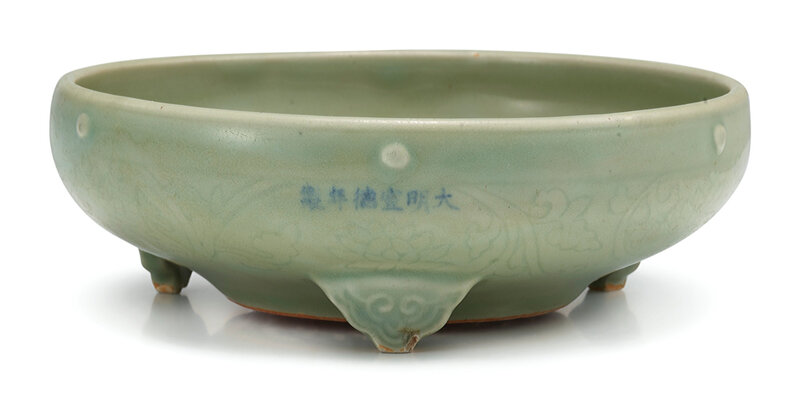


Lot 310. A rare incised celadon-glazed bulb bowl mark and period of Xuande (1426-1435); 20.7 cm. Estimate: HK$400,000 – 600,000/ US$51,500 – 77,000. Lot sold 3,960,000 HKD (445,016 EUR). Courtesy Sotheby's.
the shallow rounded sides encircled by six small raised bosses, above a carved lotus scroll band, the interior incised with leafy chrysanthemum sprays, all supported on three ruyi-shape bracket feet, covered overall save for the base in a pale celadon glaze, the exterior inscribed with a horizontal reign mark in underglaze blue.
Provenance: Sotheby's Hong Kong, 15th/16th November 1988, lot 149.
Collection of T.Y. Chao (1912-1999).
Note: It is rare to find vessels of this form and glaze with a Xuande reign mark and of the period. Shallow tripod bowls of this type were based on bronze prototypes and popular luxury items in the late Yuan and early Ming dynasty, probably used to perfume a temple or home. During the early Ming period, the Longquan kilns appear to have worked closely with the imperial kilns at Jingdezhen, thus making wares of similar form and decoration, perhaps under imperial instruction; see a Longquan celadon version relief-moulded with the Eight Trigrams below a band of flowers, attributed to the Yuan to Ming dynasty, from the collection of Mrs B.Z. Seligman and now in the British Museum, London, published in Jessica Harrison-Hall, Ming Ceramics in the British Museum, London, 2001, pl. 16:87.
Celadon-glazed vessels with underglaze blue Xuande marks and of the period, include a small celadon-glazed barbed dish decorated with incised flower scrolls, in the Taipei Palace Museum, included in the Museum’s exhibition Green-Longquan Celadon of the Ming Dynasty, 2009, cat. no. 162; a pair, from the collection of Carl Kempe, illustrated in Kinesiska Keramiska Mästerverk. I urval från Ulricehamns Östasiatiska Museum, inkluderande Dr. Carl Kempes samling./Chinese Ceramic Treasures. A Selection from Ulricehamn East Asian Museum, including The Carl Kempe Collection, Ulricehamn, 2002, p. 294, pl. 379, and sold in our Paris rooms, 12th June 2008, lot 34 and 43; and another, sold at Christie’s Hong Kong, 31st October 1994, lot 563. See also a celadon-glazed basin, incised with lotus petals on the exterior, and waves and lotus on the interior, with a six-character underglaze-blue Xuande mark beneath the rim, excavated in 1982 at Zhushan, Jingdezhen, Jiangxi province, included in the exhibition Xuande Imperial Porcelain excavated at Jingdezhen, Chang Foundation, Taipei, cat. no. 20.
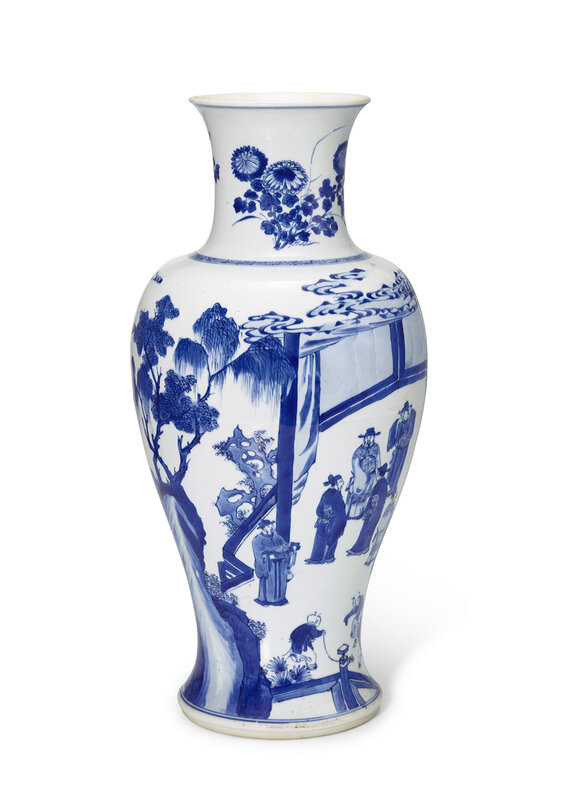
Lot 318. A blue and white vase, Qing dynasty, Kangxi period ; 46 cm. Estimate: HK$150,000 – 200,000/ US$19,200 – 25,600. Courtesy Sotheby's.

Lot 340. A finely carved yellow jade figure of a buffalo, Qing dynasty, 18th century; 6.4 cm. Estimate: HK$200,000 – 300,000/ US$25,600 – 38,400. Courtesy Sotheby's.
CERAMICS FROM THE XINYANGTANG COLLECTION
The Xinyangtang collection was formed with great passion in Hong Kong over the last 30 years under the guidance of renowned dealers in Hong Kong and Japan, and also from international auctions. Now that its owner has decided to embark on a new journey towards other categories of art, it is a great honour for Sotheby's to be able to offer the collection for sale.

Estimates range from HK$50,000 – 200,000 / US$6,400 – 25,600. Courtesy Sotheby's.
PROPERTY FROM AN OLD HONG KONG FAMILY COLLECTION
The following group of furniture and works of art were assembled in Shanghai by the parents of the present owner and brought over to Hong Kong during the 1950s when the family moved to the city.


Lot 418. A finely carved white jade 'peach and bat' ruyi sceptre, Qing dynasty, Qianlong – Jiaqing period (1723-1820); 35.2 cm. Estimate: HK$1,200,000 – 1,800,000/ US$154,000 – 230,000. Lot sold 1,750,000 HKD. Courtesy Sotheby's.
the ruyi-shaped terminal worked with a raised border enclosing a beribboned musical chime (qing) suspending a wan symbol atop a pair of peaches and a bat with outstretched wings, the lower end of the elongated arched shaft decorated with scrolling motifs, the shaft edge pierced with apertures to thread a tassel, the smoothly polished stone of an even white colour, stand and glass showcase.
Note: Finely fashioned from a large boulder, this sceptre highlights the exceptional quality of the even hues of the stone in its simple form and by restricting the carved areas of decoration to the ruyi-head and shaft end. Large boulders only became available after 1759, when the Qing military forces defeated the Dzungar Khanate and secured control over jade rich regions of Khotan and Yarkand in present day Xinjiang. A bi-annual tributary system was subsequently established between the Qing government and the four sub-Khanates of Xinjiang, securing the Imperial Workshops a steady supply of high-quality jade.
Compare a larger pale celadon jade sceptre carved with similar auspicious design on the ruyi terminal comprising of peaches, a bat and a wan emblem, but rendered with C-scrolls on the end of the shaft, from the collection of Sherry and Lawrence Philips, sold at Christie’s New York, 24th March 2004, lot 53; and a smaller white jade sceptre, the shaft decorated with branches of pomegranate and finger-citron, attributed to the Qianlong period, sold in our London rooms, 21st June 1976, lot 279. Further sceptres carved in low-relief include a smaller white jade example carved with two bats flanking a central shou character on the terminal, the shaft decorated with butterfly and floral bloom, sold in these rooms, 5th November 1996, lot 1085; and another carved with with a bat suspending a ribbon-tied qing and two peaches on the head, and a further bat on the shaft end, sold in our New York rooms, 25th February 1983, lot 287.
The motifs have been carefully selected for their auspicious connotations. The bat and the peaches carved on the head, combined with the wan symbol and the beribboned qing together form the rebus wan fu qing shou, meaning ‘may myriad birthday blessings be bestowed’. The peaches also represent immortality, said to have grown in the orchard of the Queen Mother of the West (Xiwangmu).


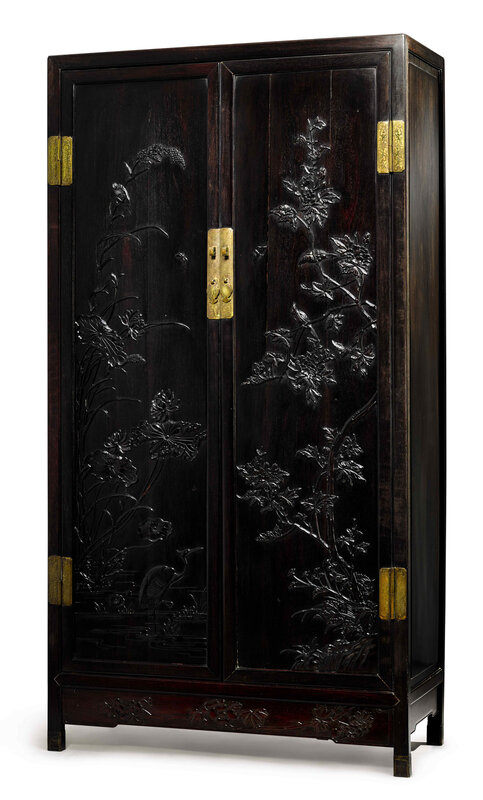
Lot 419. A rare pair of hongmu and zitan square-cornered 'flowers and birds' cabinets, Qing dynasty, 18th – 19th century ; 176 by 94 by 40.5 cm, Estimate: HK$500,000 – 700,000/ US$64,000 – 89,500. Lot sold 1,437,500 HKD. Courtesy Sotheby's.
each of corner construction opening to two interior shelves and backed with moulded panels, beautifully carved on the front doors, one cabinet with an egret standing in a lotus pond and two birds perched on branches of flowering hibiscus, the other cabinet with two couple of birds, among prunus and narcissus on one side and flowering quince above orchids on the other, the side panels with plain fielded panels, all supported on four square-section posts forming the legs, with huangtong hinges incised with dragons, central plates with lock receptacles and fish-shaped door pulls.
Note: These sophisticated cabinets are of classical square corner construction. The doors are mounted with brass hinges finely incised with intertwined archaistic dragons and flowers. There are two plain shelves without drawers on the interior and the back is made of two moulded panels, indicating a special care given to their finishing. Their proportion is well balanced and would indicate that this set was not meant to support further chests on top but are complete. The doors appear to be made of zitan while the frame, shelves and backs are made of hongmu, which can be expected considering the scarcity of
zitan at this stage of the Qing dynasty.
All four doors are exquisitely carved with birds and flowers in elegant compositions reminiscent of the earlier Kangxi and Yongzhen periods. The decoration on the panels of the four doors are meant to resemble scroll paintings, and may well be the actual reproduction of actual flowers and birds scrolls from the Qing court collection or taken from contemporary prints. The first one on the far right depicts two birds resting on plum branches, gazing at each other above rocks issuing further clusters of elderberries and narcissus. On the opposite side, two other birds play around branches of flowered quince bending above orchids. The second cabinet depicts the life in a pond, with an egret sheltered by wide lotus leaves expecting a good catch for dinner, while above, balancing on the spindly twig of a water reed, a kingfisher is about to fall on a reckless fly. On the fourth door, a graceful butterfly cannot disturb a couple of lovebirds sharing their passion in sweet melodies resonating among lush hibiscus flowers.
There are other cabinets and duobaoge featuring flowers and birds, either in huanghuali, zitan or hongmu, preserved in the Palace Museum, Beijing. See for example the side panels of a monumental pair of Zitan cabinets from the Qing court collection, illustrated in The Complete Collection of Ming and Qing Furniture in the Palace Museum vol.15, Beijing, 2015, pl. 80. This pair is similarly carved with flowers and birds enclosed in upright panels, possibly from the same pictorial source. Compare also a pair of zitan cabinets, dingxianggui, sold with Poly auctions, Beijing, 30th November 2007, lot 80. All these pieces show a distinctive style and may well originate from the same workshop, specializing in the carving of flowers and birds after early Qing Dynasty masters.
Other Zitan cabinets from the Qing Court collection, also preserved in the Palace Museum, include one carved with phoenix and another with the symbols of the Eight Immortals, illustrated in The Complete Collection of Treasures of the Palace Museum. Furniture of the Ming and Qing Dynasties (II), Hong Kong, 2002, pls 205 and 206, together with three cabinets with matching upper shelves, pls 204, 208 and 209. Compare also a slightly larger zitan cabinet carved on the front with bats, and the sides with a similar motif of a lotus pond and birds perched on flowering trees, sold at Christie’s Hong Kong, 29th November 2005, lot 1604.




Lot 430. A rare pair of pink-ground famille-rose 'Boys and Frecrackers' vases, Shendetang hall marks, Qing dynasty, Daoguang period (1821-1850); 29.8 cm. Estimate: HK$700,000 – 1,000,000 / US$89,500 – 128,000. Lot sold 4,200,000 HKD. Courtesy Sotheby's.
each well-potted with an ovoid body rising from a short splayed foot to a tall waisted neck and flaring rim, the neck flanked by a pair of stylised dragon handles with gilt highlights, the exterior of the body enamelled with a continuous scene, depicting five boys dressed in lavish winter clothing and lighting firecrackers in a garden laden with ripe fruits and lingzhi, all between a pink-ground and a turquoise-ground ruyi-band, the neck decorated with lotus scrolls and bats against a pink ground, the interior and base enamelled turquoise, the base inscribed in iron-red with a four-character Shendetang zhi hall mark, wood stands.
Note: Vibrantly painted with a playful scene of boys playing with firecrackers, this pair of vases belong to a select group of porcelain wares made during the Daoguang reign to furnish his newly built Shengdetang (Hall of Prudent Virtue). Part of the Jiuzhouqingyan complex in the Yuanming Yuan, the Shendetang was completed in 1831, and became the Emperor’s preferred residence. Featuring three connecting wave roofs on a square-shaped structure, the hall was markedly different from the more characteristic Confucian-inspired architecture, a feature that was reflected in the style of porcelain that was lavishly produced for it. This special group of wares are attributable to two decades between 1831 and 1850 and are often characterised by novel and lavish designs, as seen with this pair of vases.
A vase of this type and painted with this motif, but with a key-fret band on the neck, from the Georg Weishaupt collection, illustrated in Chinese and Japanese Porcelain of the 19th and 20th Centuries and their Forerunners, Stuttgart, 2002, pl. 38, was sold at Christie’s Hong Kong, 16th January 1989, lot 706; two slightly larger examples were sold in our New York rooms, 28th November 1994, lot 382 and 383, the first with yellow and turquoise-ground flower-scroll borders, and the second with a pink ground and elaborate dragon handles; another was sold in our London Colonnade rooms, 18th July 1994, lot 154; and a further vase but with a Daoguang reign mark and of the period, from the collection of Edward T. Chow, was sold in our Hong Kong rooms, 19th May 1981, lot 597. See also a vase of this type, decorated with boys on dragon boats, between blue-ground borders, in the Palace Museum, Beijing, illustrated in Zhao Congyue, Porcelains with Inscription of Shendetang Collected by the Palace Museum, Beijing, 2014, pl. 50; and another with the borders on a yellow ground, from the Huaihaitang collection, included in the exhibition Ethereal Elegance. Porcelain Vases of the Imperial Qing, Art Museum, The Chinese University of Hong Kong, Hong Kong, 2007, cat. no. 140.
The lively scene on these pieces is set in an elegant winter landscape, with the boys wearing fur coats and playing among flowering winter trees. Together with their engagement with firecrackers, it suggests that the vases were made for celebrating the New Year, when boys were encouraged to light firecrackers to ward off evil and therefore bring peace.
PROPERTY FROM AN OLD JAPANESE COLLECTION
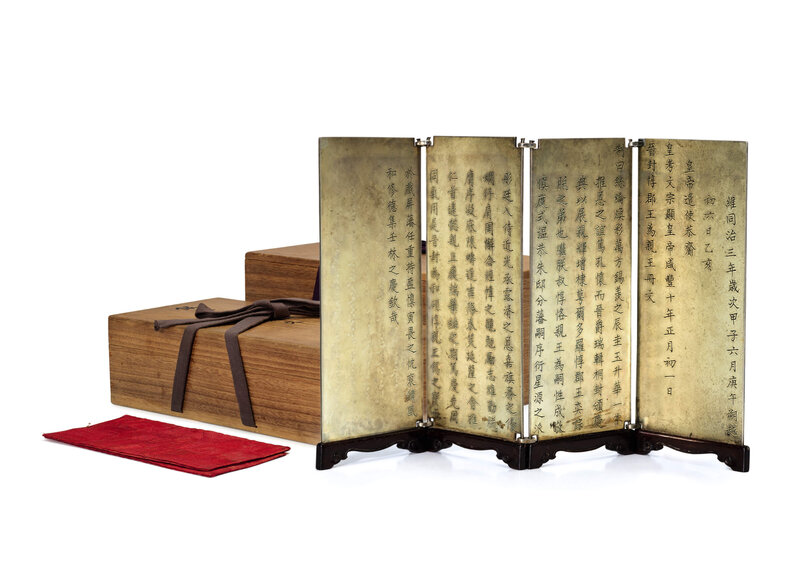
Lot 550. An important imperial inscribed gilt-silver edict conferred upon Prince Dun by Emperor Xianfeng, Qing dynasty, dated 1864 ; each leaf 22 by 10 cm, overall 24 by 42 cm. Estimate: HK$200,000 – 300,000/ US$25,600 – 38,400. Courtesy Sotheby's.



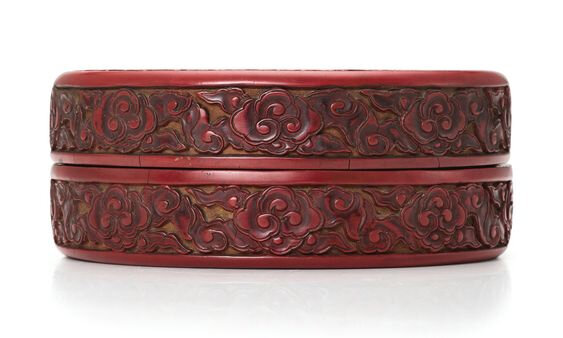

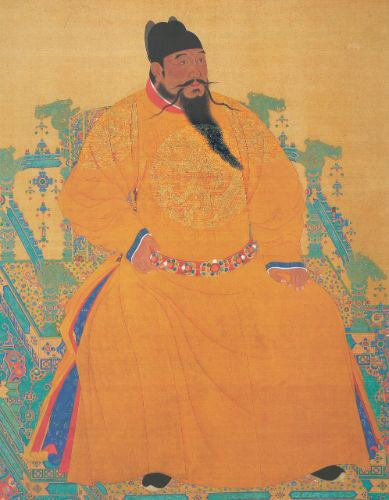

/https%3A%2F%2Fprofilepics.canalblog.com%2Fprofilepics%2F1%2F0%2F100183.jpg)
/https%3A%2F%2Fstorage.canalblog.com%2F03%2F02%2F119589%2F96711876_o.jpg)
/https%3A%2F%2Fstorage.canalblog.com%2F11%2F31%2F119589%2F94773502_o.jpg)
/https%3A%2F%2Fstorage.canalblog.com%2F20%2F83%2F119589%2F94772815_o.jpg)
/https%3A%2F%2Fstorage.canalblog.com%2F26%2F72%2F119589%2F75604929_o.jpg)
/https%3A%2F%2Fstorage.canalblog.com%2F59%2F60%2F119589%2F26458628_o.jpg)



























/http%3A%2F%2Fstorage.canalblog.com%2F91%2F12%2F119589%2F122124206_o.jpg)
/http%3A%2F%2Fstorage.canalblog.com%2F41%2F46%2F119589%2F112164159_o.jpg)
/image%2F1371349%2F20240402%2Fob_7227e1_129-1.jpg)
/image%2F1371349%2F20240329%2Fob_2076ee_113-1.jpg)